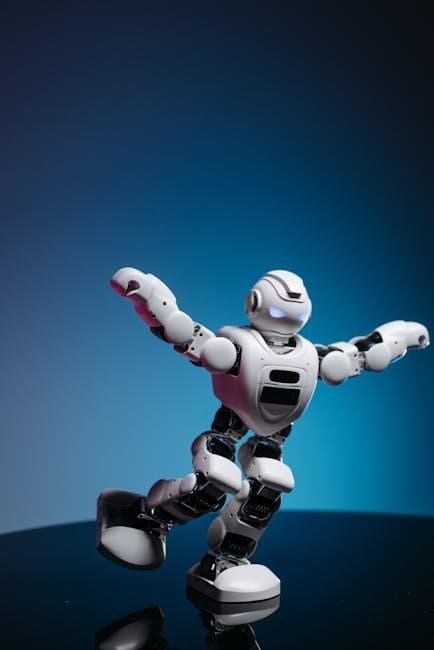Transformers for Machine Learning: A Deep Dive is the first comprehensive book on transformers, covering 60 architectures and their applications in NLP, vision, and more.
1.1 Overview of the Book “Transformers for Machine Learning: A Deep Dive”
“Transformers for Machine Learning: A Deep Dive” is a comprehensive guide tailored for machine learning practitioners seeking to master transformer-based architectures. The book begins with foundational concepts, gradually delving into advanced topics like self-attention mechanisms, multi-head attention, and positional encoding. It explores prominent models such as BERT, GPT, and Vision Transformers, highlighting their applications in NLP, computer vision, and beyond. With a focus on practical implementation, the text provides real-world case studies and best practices, making it an invaluable resource for both researchers and industry professionals. The authors emphasize the transformative impact of these models on modern AI.
1.2 Key Features of the Book
The book “Transformers for Machine Learning: A Deep Dive” stands out for its comprehensive coverage of transformer architectures, offering detailed explanations of core concepts and advanced techniques. It provides a balanced mix of theoretical insights and practical implementations, making it accessible to both beginners and experienced practitioners. The text includes code examples, case studies, and best practices, enabling readers to apply transformer models effectively. Additionally, the book highlights emerging trends and future directions, ensuring readers stay ahead in the evolving field of machine learning. Its structured approach and in-depth analysis make it an indispensable resource for anyone working with transformers.
1.3 Importance of Transformers in Modern Machine Learning
Transformers have revolutionized modern machine learning, particularly in natural language processing (NLP), by enabling models to handle sequential data more effectively. Their self-attention mechanism allows for capturing long-range dependencies, making them highly effective for tasks like translation, summarization, and text generation. Beyond NLP, transformers are increasingly applied in computer vision, speech recognition, and time-series analysis, demonstrating their versatility. Their ability to generalize across domains and scale with large datasets has made them indispensable in advancing AI capabilities, driving innovation in both research and industry applications.

Foundational Concepts of Transformers
Transformers introduced self-attention mechanisms, positional encoding, and multi-head attention, replacing traditional RNNs and CNNs with more efficient, scalable architectures for sequence modeling and feature extraction.
2.1 What Are Transformers?
Transformers are a revolutionary neural network architecture introduced in 2017, primarily designed for sequence-to-sequence tasks. They leverage self-attention mechanisms to model relationships between input elements, enabling efficient processing of long-range dependencies. Unlike RNNs or CNNs, transformers process all parts of the input simultaneously, making them highly parallelizable and scalable. This innovation has made transformers the backbone of modern NLP, with applications extending to vision, speech, and beyond. Their ability to capture contextual relationships has driven breakthroughs in language modeling, translation, and generative tasks, solidifying their role as a cornerstone of deep learning;
2.2 Historical Context and Evolution of Transformers
Transformers emerged in 2017 as a groundbreaking solution to the limitations of traditional neural networks; Introduced by the Google Brain team, they revolutionized sequence-to-sequence tasks by replacing RNNs and CNNs with self-attention mechanisms. The original “Attention Is All You Need” paper laid the foundation, showcasing superior performance in machine translation. Since then, transformers have evolved rapidly, with advancements like multi-head attention and positional encoding. Their success in NLP led to adaptations in vision and speech, making them a versatile tool in modern AI. This evolution underscores their transformative impact on deep learning and their continued dominance in the field.
2.3 Core Components of Transformer Architecture
The Transformer architecture is built around self-attention mechanisms, encoder-decoder structures, and multi-head attention. The encoder processes input sequences into continuous representations, while the decoder generates output sequences. Each encoder and decoder layer contains sub-layers for multi-head attention and position-wise feed-forward networks. Positional encoding adds sequence information, crucial for order-aware processing. Residual connections and layer normalization enhance training stability. The multi-head attention mechanism allows the model to capture diverse relationships, making it highly effective for sequence-to-sequence tasks. These components collectively enable Transformers to handle long-range dependencies and parallel processing efficiently, setting them apart from traditional RNNs and CNNs.

Transformer Architecture Deep Dive
Transformers revolutionized machine learning with their encoder-decoder architecture and self-attention mechanisms. This section explores how they process input sequences, capture contextual relationships, and enable efficient parallel processing.
3.1 The Role of Self-Attention Mechanisms
Self-attention mechanisms are the backbone of Transformer architectures, enabling models to weigh the importance of different input elements dynamically. By computing pairwise relationships between tokens, they capture long-range dependencies and contextual interactions. This mechanism allows Transformers to focus on relevant parts of the input when processing each element, enhancing their ability to understand complex patterns. The query-key-value framework facilitates efficient computation, making self-attention both powerful and scalable. This innovation eliminates the need for fixed-length contexts, enabling parallel processing and improving model performance across various tasks.
3.2 Multi-Head Attention and Its Benefits
Multi-head attention is a critical advancement in Transformer architectures, enabling models to capture diverse types of relationships within data. By splitting attention into multiple heads, each focusing on different aspects of the input, the model gains a richer understanding of context. This approach improves representation learning and enhances the ability to handle long-range dependencies. Multi-head attention also allows parallel processing, increasing efficiency. The combination of heads enables the model to jointly attend to information from different representation subspaces, leading to improved performance in tasks like translation and question answering.
3.3 Positional Encoding and Its Significance
Positional encoding is a crucial component in Transformer architectures, as it enables the model to understand the order and position of input elements. Since Transformers process sequences in parallel and lack inherent positional awareness, positional encoding injects information about the position of each token. This is typically achieved through sine and cosine functions, creating a fixed positional embedding for each token. The addition of these embeddings allows the model to capture sequential relationships and long-range dependencies effectively. This mechanism is vital for tasks like language translation and text generation, where word order and context are essential for meaningful outputs.

Advanced Transformer Architectures
Explore cutting-edge transformer models like BERT, GPT, and Vision Transformers, designed for specific tasks, enhancing performance in NLP, computer vision, and beyond.
4.1 BERT and Its Impact on NLP
BERT (Bidirectional Encoder Representations from Transformers) revolutionized NLP by introducing a pre-training approach that captures contextual relationships in text. Its masked language modeling technique allows models to understand nuances in language better than previous methods. BERT’s success lies in its ability to fine-tune for specific tasks, achieving state-of-the-art results across benchmarks like GLUE and SQuAD. Its impact extends to real-world applications, enabling advancements in question answering, text classification, and language translation. BERT’s influence has also inspired the development of other transformer-based models tailored for specific NLP tasks, solidifying its role as a foundational breakthrough in the field.
4.2 GPT and Other Language Models
GPT (Generative Pre-trained Transformer) has emerged as a groundbreaking language model, excelling in text generation and understanding. Its decoder-only architecture enables coherent and contextually relevant output, making it ideal for applications like chatbots and content creation. The GPT series, including GPT-3 and GPT-4, has demonstrated remarkable improvements in generative capabilities. Other notable models like T5 and Pegasus have also contributed significantly, offering specialized functionalities such as text-to-text transformations and abstractive summarization. These models collectively redefine the possibilities of natural language generation, pushing the boundaries of AI-driven communication and creativity.
4.3 Vision Transformers (ViT) and Their Applications
Vision Transformers (ViT) have revolutionized computer vision by extending the transformer architecture to image processing. By treating images as sequences of patches, ViT leverages self-attention mechanisms to capture long-range dependencies, achieving state-of-the-art results in tasks like classification and object detection. Initially trained on large datasets such as ImageNet, ViT has expanded into medical imaging, autonomous vehicles, and more. Its ability to generalize across domains makes it a versatile tool, while its interpretability advantages over CNNs further enhance its appeal. The book explores ViT’s architecture, applications, and its role in advancing multimodal AI systems.

Applications of Transformers
Transformers have revolutionized machine learning across domains, enabling breakthroughs in NLP, computer vision, speech processing, and time series analysis, making them a versatile tool for modern AI.
5.1 Natural Language Processing (NLP)
Transformers have revolutionized NLP by enabling state-of-the-art performance in tasks like text classification, language translation, and question answering. Their self-attention mechanisms allow models to capture long-range dependencies and contextual relationships in text effectively. Pre-trained models such as BERT and RoBERTa leverage transformers to achieve exceptional results in understanding and generating human language. Applications include sentiment analysis, named entity recognition, and summarization. The ability to process sequential data efficiently makes transformers indispensable in modern NLP pipelines, driving advancements in chatbots, language translation systems, and document analysis.
5.2 Computer Vision and Image Processing
Transformers are increasingly applied in computer vision, challenging traditional CNN-based approaches. Vision Transformers (ViT) process images by dividing them into patches and using self-attention to capture global features. This approach excels in tasks like image classification, object detection, and segmentation. Transformers enable models to understand contextual relationships between image regions better than conventional methods. Applications include medical imaging, autonomous vehicles, and facial recognition. By leveraging multi-head attention, Transformers achieve state-of-the-art performance, offering robust solutions for complex visual data challenges.
5.3 Speech Recognition and Audio Processing
Transformers have revolutionized speech recognition and audio processing by enabling better modeling of sequential data. The self-attention mechanism captures long-range dependencies in audio signals, improving tasks like voice recognition and transcription. Transformers-based models, such as Wav2Vec, achieve state-of-the-art results in automatic speech recognition. They also excel in music classification, audio event detection, and speech enhancement. By processing audio as sequences of spectrograms or raw waveforms, Transformers leverage their ability to handle variable-length inputs. This versatility makes them indispensable in advancing speech and audio technologies, driving innovation in voice assistants, podcasts, and more.
5.4 Time Series Analysis and Forecasting
Transformers have emerged as powerful tools for time series analysis and forecasting due to their ability to model sequential data effectively. The self-attention mechanism captures complex patterns and long-range dependencies in time series, enabling accurate predictions. Transformers handle variable-length inputs and multivariate data seamlessly, making them ideal for tasks like stock market prediction, energy consumption forecasting, and climate modeling. Recent models, such as TimeSformer and Informer, demonstrate superior performance over traditional methods like ARIMA and LSTM. Their parallel processing capability also accelerates training, making them highly efficient for real-time applications and large-scale datasets.
Transformer Architectures Covered in the Book
The book explores over 60 transformer architectures, detailing their unique designs, strengths, and applications. It covers prominent models like BERT, GPT, and ViT, as well as niche variants.
6.1 Overview of 60 Transformer Architectures
The book provides a comprehensive overview of 60 transformer architectures, highlighting their diversity and evolution. It spans models from early NLP-focused designs to modern, domain-agnostic architectures. Readers gain insights into how these models adapt to tasks like vision, speech, and time series analysis. Each architecture’s unique features, strengths, and applications are concisely presented, offering a broad understanding of the transformer landscape. This section serves as a foundation for deeper exploration in subsequent chapters.
6.2 Detailed Analysis of Prominent Architectures
The book delves into prominent transformer architectures, offering in-depth analysis of their design choices and performance. Models like BERT, GPT, and Vision Transformers are explored, with a focus on their unique contributions. Readers learn how these architectures address specific challenges, such as language modeling or image processing. The analysis highlights key innovations, including self-attention mechanisms and multi-head attention, while discussing their practical implications. This section provides a nuanced understanding of what makes these models successful and how they can be applied effectively in real-world scenarios.
6.3 Comparative Study of Different Models
The book provides a comprehensive comparison of various transformer models, highlighting their strengths and weaknesses. It evaluates models like BERT, RoBERTa, and GPT across tasks such as NLP, computer vision, and speech processing. Performance metrics, including accuracy, computational efficiency, and resource requirements, are analyzed. The comparison also explores architectural innovations and their impact on model capabilities. This section helps practitioners and researchers understand which models are best suited for specific use cases, enabling informed decisions for real-world applications. The analysis serves as a valuable resource for advancing AI development.

The Evolution of Transformers
Transformers evolved from traditional neural networks, addressing sequence-to-sequence tasks; They revolutionized handling long-range dependencies and parallel processing, leading to continuous improvements in efficiency and adaptability.
7.1 From Traditional Neural Networks to Transformers
Traditional neural networks, like RNNs and CNNs, faced limitations in handling long-range dependencies and parallel processing. Transformers emerged as a breakthrough, introducing self-attention mechanisms that enable efficient processing of sequential data. By abandoning traditional convolutional and recurrent structures, transformers achieved state-of-the-art performance in tasks like machine translation and text generation. This shift marked a paradigm change in machine learning, offering unparalleled scalability and flexibility. The transformer architecture’s success stems from its ability to capture contextual relationships and process data in parallel, revolutionizing approaches to NLP and beyond.
7.2 Key Adaptations and Alterations Over Time
The transformer architecture has undergone significant adaptations since its inception. Early modifications included improvements in self-attention mechanisms and positional encoding. Later advancements introduced scaled dot-product attention and multi-head attention, enhancing model capacity. BERT popularized masked language modeling, while GPT models expanded transformer depth and width. Vision Transformers adapted the architecture for image processing by introducing patch-based inputs. Each adaptation addressed specific challenges, such as computational efficiency or domain applicability. These modifications have enabled transformers to dominate various machine learning tasks, driving continuous innovation in model design and application.
7.3 Emerging Trends and Future Directions
Transformers continue to evolve, with emerging trends focusing on efficiency and adaptability. Researchers are exploring lightweight architectures to reduce computational costs while maintaining performance. Hybrid models combining transformers with convolutional or recurrent networks are gaining traction. Multimodal transformers capable of processing diverse data types (e.g., text, images, audio) are becoming increasingly popular. Advances in few-shot and zero-shot learning aim to enhance generalization. Sustainability is another focus, with efforts to make transformers more energy-efficient. These innovations promise to expand transformer applications across industries, driving AI advancements in areas like healthcare, robotics, and autonomous systems.

Challenges and Limitations of Transformers
Transformers face challenges like scalability, interpretability, and dependency on large datasets. They require significant computational resources and expertise, limiting accessibility for smaller organizations.
8.1 Computational Complexity and Resource Requirements
Transformers’ computational complexity, primarily driven by self-attention mechanisms, scales quadratically with sequence length, making them resource-intensive. Training large models like BERT or GPT requires significant GPU/TPU power, substantial memory, and large datasets. This high computational demand limits accessibility for smaller organizations and projects with limited resources. Additionally, the massive parameter count in modern architectures increases energy consumption and operational costs. While optimizations like pruning and quantization help mitigate these challenges, they often come at the expense of model performance, creating a trade-off between efficiency and capability.
8.2 Challenges in Training and Optimization
Training transformers presents unique challenges due to their complex architecture. The self-attention mechanism requires careful handling of vanishing or exploding gradients, often mitigated with techniques like gradient clipping. Optimization is further complicated by the need for large batch sizes and extensive computational resources. Additionally, the deep nature of transformer models can lead to overfitting, necessitating regularization methods like dropout. Learning rate scheduling and proper weight initialization are critical to ensure stable training. These challenges highlight the importance of advanced optimization strategies and architectural adaptations to achieve optimal performance in transformer-based models.
8.3 Limitations in Specific Domains
Transformers, despite their dominance, face limitations in specific domains. In computer vision, Vision Transformers often struggle with small datasets and require extensive pre-training. For time-series analysis, their ability to capture long-range dependencies can be less effective than traditional methods. In speech recognition, processing continuous audio signals remains challenging. Additionally, cross-lingual NLP tasks highlight limitations in handling low-resource languages. Multi-modal tasks also pose difficulties due to integration complexities. These limitations underscore the need for domain-specific adaptations and hybrid approaches to fully leverage transformer capabilities in specialized fields.

Practical Implementations and Case Studies
Exploring real-world applications of transformers across industries, including NLP, vision, and more, with detailed case studies showcasing their impact and implementation strategies.
9.1 Real-World Applications of Transformers
Transformers have revolutionized machine learning applications across industries. In NLP, they power text generation, summarization, and translation, with models like GPT and BERT leading advancements. In computer vision, Vision Transformers (ViT) excel in image classification and object detection. Transformers also enhance speech recognition systems and time series forecasting, demonstrating versatility. Real-world applications include chatbots, recommendation systems, and medical diagnosis tools. Their ability to handle sequential data efficiently makes them indispensable in modern AI solutions, driving innovation and improving performance across domains.
9.2 Case Studies from Various Industries
Transformers are driving innovation across industries, as highlighted in “Transformers for Machine Learning: A Deep Dive.” In healthcare, transformers enable precise medical diagnosis and drug discovery. Finance leverages them for fraud detection and algorithmic trading. Retail benefits from personalized recommendations and inventory optimization. Entertainment platforms use transformers for content curation and user engagement. Education sees advancements in adaptive learning systems. These case studies demonstrate the transformative impact of transformer models, showcasing their versatility and ability to solve complex problems across diverse domains, driving efficiency and innovation.
9.3 Best Practices for Implementing Transformers
When implementing transformers, start with pre-trained models and fine-tune them for specific tasks to leverage transfer learning. Ensure proper data preprocessing, including tokenization and padding. Use appropriate attention mechanisms and optimize hyperparameters like head count and dropout rates. Regularly monitor performance metrics and implement early stopping to avoid overfitting. For efficiency, utilize distributed training and mixed-precision techniques. Lastly, consider model interpretability tools to understand decision-making processes. These practices, as detailed in “Transformers for Machine Learning: A Deep Dive,” help maximize model performance and reliability across various applications.

Resources for Further Learning
Explore official documentation, tutorials, and community forums for comprehensive insights into transformer implementations and advancements.
10.1 Recommended Reading and Research Papers
To deepen your understanding of transformers, explore seminal papers like “Attention Is All You Need” by Vaswani et al., which introduced the transformer architecture. Additional key papers include “BERT: Pre-training of Deep Bidirectional Transformers for Language Understanding” and “An Image is Worth 16x: Transformers for Image Recognition at Scale,” which highlight advancements in NLP and vision. For comprehensive learning, refer to books like “Transformers for Natural Language Processing” by Denis Rothman. These resources provide foundational and cutting-edge insights, catering to both researchers and practitioners. They are essential for advancing your knowledge in transformer-based machine learning.
10.2 Online Courses and Tutorials
10.3 Communities and Forums for Discussion
Engaging with communities and forums is essential for deepening knowledge and staying updated on transformers. Platforms like Reddit’s r/MachineLearning and r/NLP host vibrant discussions on transformer models and applications. Stack Overflow is a go-to for troubleshooting and technical queries. GitHub repositories, such as those for Hugging Face’s Transformers library, offer collaborative spaces for open-source projects. Kaggle forums and specialized AI groups on LinkedIn also provide valuable insights and resources. These communities foster collaboration, knowledge sharing, and problem-solving, making them indispensable for both beginners and experts in the field of machine learning and transformer-based technologies.

The Role of Transformers in Modern AI
Transformers have revolutionized AI by enabling advanced NLP, vision, and multimodal processing. Their versatility and scalability make them fundamental to modern AI systems and applications.
11.1 Transformers as General-Purpose Models
Transformers have emerged as versatile, general-purpose models, excelling in various domains beyond NLP, including computer vision and multimodal tasks. Their architecture, particularly self-attention, enables capturing long-range dependencies and contextual relationships, making them adaptable across data types. This versatility allows transformers to generalize well, from text generation to image classification. The success of models like BERT and Vision Transformers (ViT) underscores their broad applicability. Continuous architectural innovations further enhance their ability to handle diverse tasks, solidifying their role as foundational components in modern AI systems. Their scalability and flexibility make them indispensable for both research and practical applications.
11.2 Their Impact on AI Research and Development
Transformers have revolutionized AI research and development, setting new standards for model performance and versatility. By enabling efficient processing of sequential data and capturing complex patterns, they have driven advancements in NLP, computer vision, and multimodal systems. Their success has spurred innovation in architecture design, training techniques, and applications across industries. Transformers have also accelerated the adoption of deep learning in real-world scenarios, fostering interdisciplinary research and collaboration. Their impact extends to hardware development, with optimizations tailored for transformer-based computations. As a result, transformers continue to shape the trajectory of AI research and its practical applications.
11.3 Ethical Considerations and Future Implications
Transformers raise significant ethical concerns, particularly regarding data privacy, bias, and environmental impact. Their reliance on vast datasets poses risks of perpetuating biases and infringing on privacy. Additionally, the high computational demands for training large models contribute to energy consumption and carbon emissions. Looking ahead, future implications include the potential for misuse in generating misleading content or surveillance. Ensuring transparency, accountability, and responsible innovation is crucial. Balancing technological advancement with ethical practices will be essential as transformers continue to shape AI’s evolution and integration into society.
Transformers have revolutionized machine learning, offering unparalleled capabilities in processing sequential data and enabling advanced applications across NLP, vision, and beyond. This concludes our comprehensive exploration.
12.1 Summary of Key Takeaways
Transformers have revolutionized machine learning, enabling state-of-the-art performance in sequential data processing. This book provides a comprehensive understanding of Transformer architectures, from foundational concepts to advanced models like BERT, GPT, and Vision Transformers. Readers gain insights into self-attention mechanisms, positional encoding, and multi-head attention, alongside practical implementation strategies. The book also explores challenges, such as computational complexity and training difficulties, while highlighting emerging trends and ethical considerations. By balancing theory and practice, it equips practitioners with the knowledge to leverage Transformers effectively in real-world applications, making it an indispensable resource for both beginners and experts.
12.2 Final Thoughts on the Future of Transformers
Transformers are poised to continue shaping the future of machine learning, with advancements in efficiency, scalability, and adaptability. Future models may prioritize task-agnostic architectures, enabling broader applicability across domains. Multimodal capabilities will likely expand, bridging gaps between text, vision, and audio processing. Ethical considerations, such as bias mitigation and energy consumption, will remain critical. As research progresses, balancing innovation with practicality will be key. The book underscores the transformative potential of these models, inspiring further exploration and innovation in the field.
